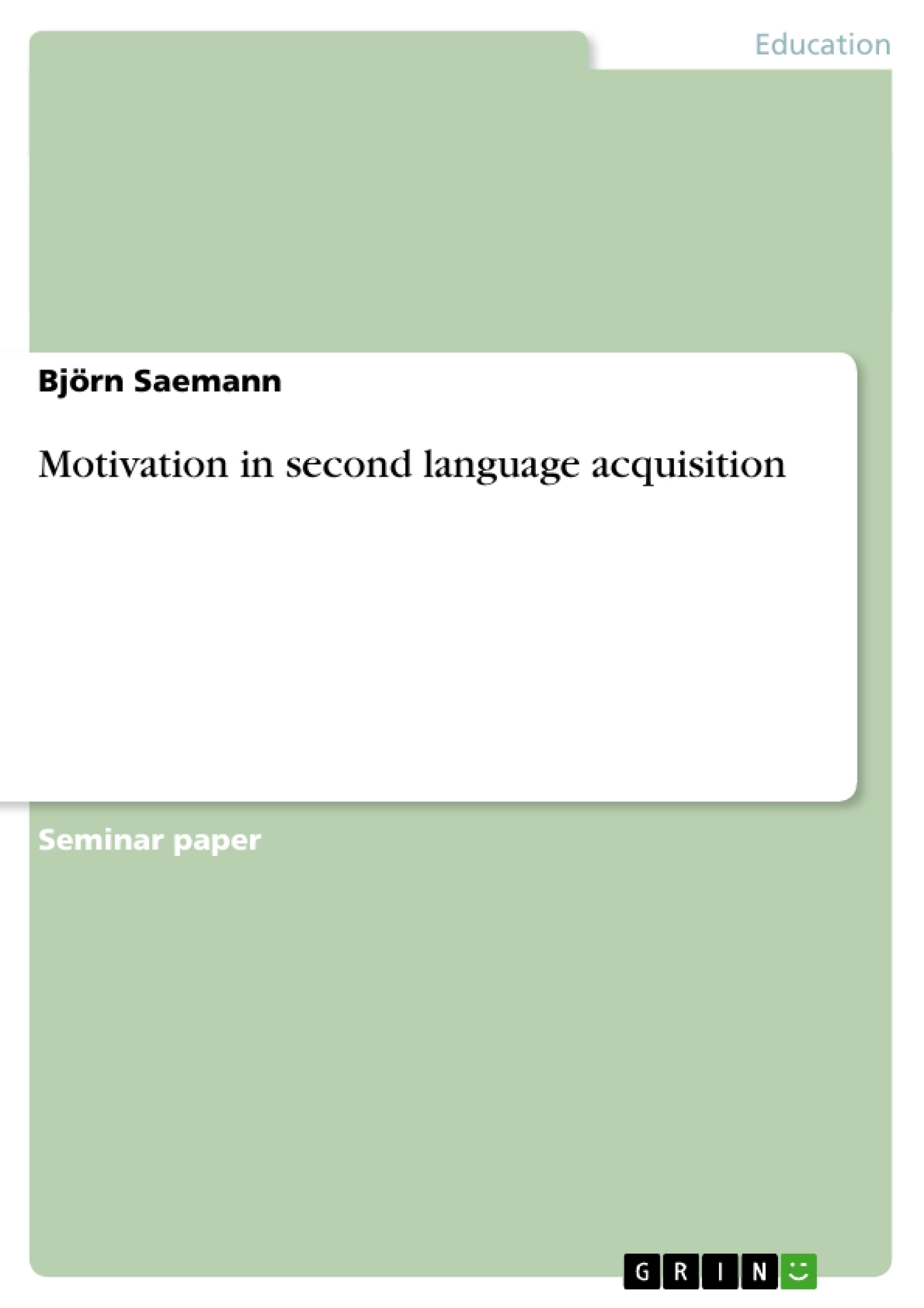This paper is about motivation in second language acquisition. First the term
“motivation” will be defined and explained. Afterwards this paper will explain
what different kinds of motivation exist and how they help to learn language. I
will focus on the work of Rod Ellis and Robert C. Gardner as well as the works
of Kimberly A. Noels.
The final part of the paper will discuss motivation in the classroom and how to
improve the motivation of students as a teacher. For this part I will focuse on
the works of J. Brophy. Motivation is often named together with aptitude. Therefore it is vital to define
the difference between aptitude and motivation.
Ellis (2008:75) states while aptitude describes the “cognitive abilities that
underlie successful L2 acquisition, motivation involves the attitudes and
affective states that influence the degree of effort that learners make to learn
an L2”.
So aptitude is a more or less stable component which the individual can not
directly interfere with. Motivation on the other hand is a component that can
change comparatively fast and can be altered by the learner himself.
Gardner (2001) writes that motivation describes the driving force behind the
effort of a learner. Motivation consists of three elements. The first element is
“effort”. A more motivated learner will put more effort in his or her studies. He
will be open to do extra work in order to improve his language skills, spend
more time with studying for the language and even deal with the subject on a
subconscious level. [...]
Inhaltsverzeichnis
- Introduction
- Definition of motivation
- Different kinds of motivation and motivation theories
- Integrative Motivation
- Instrumental Motivation
- Intrinsic Motivation
- Extrinsic Motivation
- Motivation in the classroom
- Conclusion
- References
Zielsetzung und Themenschwerpunkte
This paper aims to explore the role of motivation in second language acquisition. It defines the concept of motivation, examines different types of motivation and their influence on language learning, and discusses practical implications for classroom settings. The paper draws on the works of prominent researchers in the field, including Rod Ellis, Robert C. Gardner, and Kimberly A. Noels.
- Definition and distinction between motivation and aptitude
- Different types of motivation: integrative, instrumental, intrinsic, and extrinsic
- The role of motivation in language learning success
- Strategies for enhancing student motivation in the classroom
- The impact of affective factors on language acquisition
Zusammenfassung der Kapitel
The introduction provides an overview of the paper's focus on motivation in second language acquisition. It outlines the key concepts and research areas that will be explored. The definition of motivation section clarifies the distinction between motivation and aptitude, highlighting the importance of both factors in language learning. It also introduces the three key elements of motivation: effort, desire, and affect.
The chapter on different kinds of motivation delves into various types of motivation, including integrative, instrumental, intrinsic, and extrinsic motivation. It examines the theoretical frameworks and empirical evidence supporting each type of motivation, exploring their influence on language learning outcomes. The chapter also discusses the concept of "Machiavellian motivation" as a twisted form of integrative motivation.
The chapter on motivation in the classroom explores practical strategies for enhancing student motivation in language learning settings. It draws on the works of J. Brophy and other researchers to provide insights into effective teaching practices that foster motivation and engagement. The chapter also discusses the importance of creating a positive learning environment and addressing individual student needs.
Schlüsselwörter
The key terms and focus themes of the text include motivation, second language acquisition, integrative motivation, instrumental motivation, intrinsic motivation, extrinsic motivation, language learning, classroom motivation, affective factors, and language aptitude.
- Arbeit zitieren
- Björn Saemann (Autor:in), 2009, Motivation in second language acquisition, München, GRIN Verlag, https://www.grin.com/document/126974
-

-

-

-
Laden Sie Ihre eigenen Arbeiten hoch! Geld verdienen und iPhone X gewinnen. -

-
Laden Sie Ihre eigenen Arbeiten hoch! Geld verdienen und iPhone X gewinnen. -

-
Laden Sie Ihre eigenen Arbeiten hoch! Geld verdienen und iPhone X gewinnen. -

-
Laden Sie Ihre eigenen Arbeiten hoch! Geld verdienen und iPhone X gewinnen. -

-
Laden Sie Ihre eigenen Arbeiten hoch! Geld verdienen und iPhone X gewinnen.

